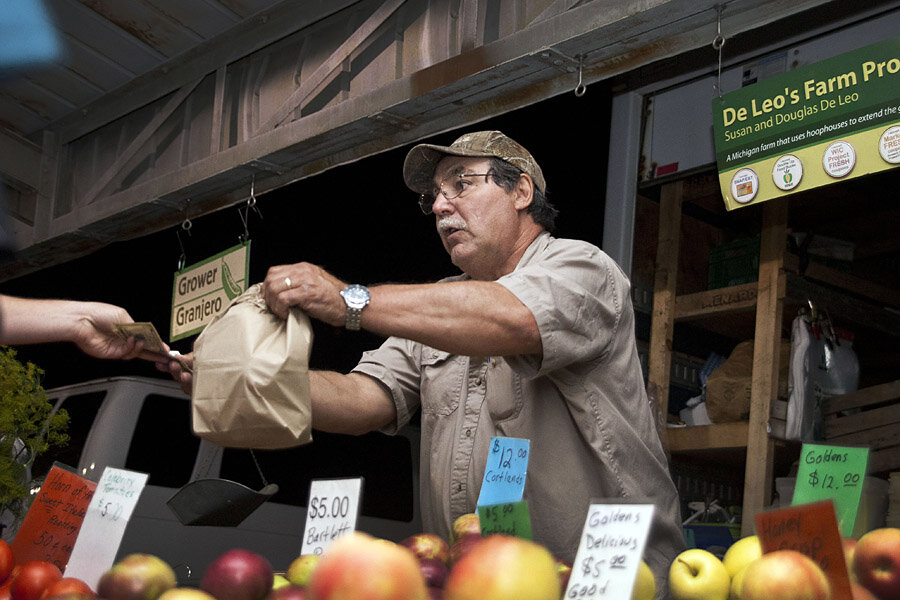Eleven great apps to help you navigate the farmers market
Loading...
Picking the best in-season produce with the lowest pesticide levels or purchasing the most sustainable seafood at the local farmers market can be a challenge. Here are a few apps that help increase the impact of each market visit for buyers and sellers alike.
Dirty Dozen. Free. Published by the Environmental Working Group (EWG), a nonprofit environmental research organization. This app focuses on which types of conventionally raised produce are the lowest in pesticides and which types are the highest. Lists include the Dirty Dozen, like apples, spinach, and grapes, and the Clean Fifteen, like sweet corn, asparagus, and cantaloupe. The app helps decide when finding an organic alternative is especially important. The Dirty Dozen Plus, an expanded app, includes a list of hot peppers and leafy greens.
Farmstand. Free. The app lists more than 8,700 farmers markets around the world and connects shoppers with markets for locally grown food. It supports local communities by supporting linking users to each other by allowing them to take and post pictures of markets and vendors, alert others to great finds, and browse information posted by fellow market-goers. Markets can be sorted by location and opening times.
Good Guide. Free. A wide-ranging shopping app that includes everything from produce to pet food, the Good Guide rates products and producers according to their environmental and social benefits. In the case of fresh produce, dairy, and meats, items can be sorted using filters such as organic, vegan, and specific nutrition aspects (low sodium, etc.). The app can be tailored to highlight shoppers’ personal requirements.
Harvest. Paid. The app provides a list of pesticide levels on fruit and vegetables and instructs shoppers on methods for picking the best and ripest piece in-season produce, from shaking blueberries to knocking on watermelons. It also provides information on the best means of storage for different kinds of produce.
HarvestMark Food Traceability. Free. Participating fruit, vegetable, and dairy brands label their products with a 16-digit HarvestMark code or QR code; shoppers use the app to scan the code, retrieve the product’s harvest information, and give feedback. The app connects food producers with their customers and offers food production transparency.
Locavore. Free. Locavore has a large database of local farmers markets, farms, Community Supported Agriculture (CSA), and vendors selling organic produce and in-season foods. It showcases recipes using in-season ingredients and also allows users to tag local sellers, share reviews, and post new finds.
Love Food Hate Waste. Free. Produced by the United Kingdom-based organization WRAP, the app helps shoppers reduce food waste by better organizing their kitchen, cooking, and shopping habits. It helps eaters keep track of what’s in their cupboards, posts alerts where there are duplicate items, highlights recipes for how to best use the food that’s already there, and cuts down on unnecessary purchases.
Seafood Watch (U.S.) / Good Fish Guide (U.K.). Free. Optimized for use in the United States or in the United Kingdom respectively, these two apps help shoppers identify the most sustainable seafood options at the market. Seafood Watch highlights best choices and indicates the options to avoid. The Good Fish Guide uses a traffic light rating system.
Seasons. Paid. The app lists natural growing season data and local availability of hundreds of kinds of produce, from herbs to mushrooms to fruits. It also includes the import seasons of produce, photos, and the location of farmers markets around the world.
True Food. Free. Some countries, including the United States, do not require mandatory labeling of genetically modified organisms (GMOs). This app, created by the nonprofit environmental advocacy organization Center for Food Safety, helps shoppers identify which foods contain GMOs, including dairy products, meat, and meat alternatives.
What’s on my food? Free. Created by the Pesticide Action Network (PAN), this app accesses an extensive and up-to-date database of all pesticides used on various kinds of produce. Pesticide residues remain on some fruits and vegetables even after washing. Watermelon in the United States, for example, can have up to 26 different pesticide residues by the time it reaches market, according to PAN. The app illuminates the effects of each pesticide.







